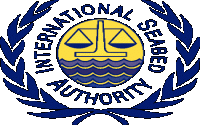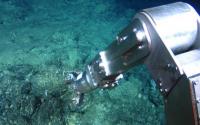International Seabed Authority

Quicktabs: Keywords

The UN-affiliated organisation that oversees deep-sea mining, a controversial new industry, has been accused of failings of transparency after an independent body responsible for reporting on negotiations was kicked out.
[ More ]
Vast new areas of the ocean floor have been opened up in an accelerating search for valuable minerals including manganese, copper and gold. In a move that brings closer a new era of deep sea mining, the UN's International Seabed Authority (ISA) has issued seven new exploration licences.
[ More ]It remains a fair question whether a complex U.N. regulatory bureaucracy—especially one that counts international wealth redistribution as one of its functions—is a reassuring presence for investors. The 1994 Agreement does not actually abolish the Planning Commission, but simply suspends its operations until the regulatory council of the Authority “decides otherwise.”15 The Seabed Authority still proclaims, on its official website, that it will oversee “action to protect land-based mineral producers in the third world from adverse economic effects of seabed production.” The 1994 Agreement seems to give at least tacit support to this notion in empowering the Authority to provide “economic assistance” to “developing countries which suffer serious adverse effects on their export earnings” from deep seabed mining.16 The Authority can still direct proceeds from mining or drilling approved for the continental shelf to compensate “affected developing land-based producer States.” If the world wants to encourage mining in the deep seabed, this is no way to do it.
Now, how about this new agency [International Seabed Authority] being a precursor for world government? Well, it has been in existence for twenty-five years. It has a staff of thirty-five, counting the secretaries, and it has a total budget of less than $12 million.21 World government? I do not think so. This is simply yet another run-of-the-mill international organization. There are hundreds, like the U.S.- Canadian Fisheries Convention, the International Maritime Organization, and many others. This is not something fundamentally different.
The Authority, though so far of modest size, would suffer from the same perverse incentives that afflict the U.N., since the United States would be responsible for 25 percent of the budget but easily outmaneuvered. Proposals by industrialized signatories to limit their contributions have so far received an unfriendly reception. Still, when it signed the Law of the Sea Treaty, the Clinton administration said there was no reason to worry, because the treaty proclaims that "all organs and subsidiary bodies to be established under the Convention and this Agreement shall be cost-effective." Right. Presumably just as cost-effective as the U.N.
Voting in the ISA so far gives no reason for optimism. Electing members to the dominant Council has proven to be no easy task, with substantial disagreement over membership criteria and political horse- trading.9 For instance, in 1996 there were 22 candidates for 15 seats on the Legal and Technical Commission. But the Council, rather than select from this pool, simply expanded the membership to 22. Five years later there were 24 candidates in the election, so the Council again increased the size of the panel. During the 2004 election for ISA Secretary-General, substantial pressure was applied to the three candidates who were apparently trailing to withdraw to avoid having a contested election.10
The revised treaty retains the ISA’s ability to impose production controls. Negotiators excised provisions that set a convoluted ceiling on seabed production, but they preserved Article 150, which, among other things, states that the ISA is to ensure “the protection of developing countries from adverse effects on their economies or on their export earnings resulting from a reduction in the price of an affected mineral, or in the volume of exports of that mineral.”
Funding remains a problem as well. The United States, naturally, would be expected to provide the largest share of the ISA’s budget: 25 percent to start. How much that would be is impossible to predict; the budget is to be developed through “consensus” by the Finance Committee, on which the United States is temporarily guaranteed a seat (“until the Authority has sufficient funds other than assessed contributions to meet its administrative expenses”).32 After the Finance Committee vote, the budget must be approved by the Assembly and the council. Years ago the United Nations estimated that the ISA would cost between $41 million and $53 million annually, on top of initial office construction costs of between $104 million and $225 million.33 The Clinton administration contended that the revised agreement provided for “reducing the size and costs of the regime’s institutions.”34 How? By adopting a paragraph pledging that “all organs and subsidiary bodies to be established under the Convention and this Agreement shall be cost-effective.”35 Similarly, states the amended accord, the royalty “system should not be complicated and should not impose major administrative costs on the Authority or on a contractor.”36
These sentiments might be genuine. So far the ISA has been spending only about $5 million annually. But then, the world’s wealthiest nation is not yet a member. Moreover, the revised agreement has changed none of the underlying institutional incentives that bias virtually every international organization, most obviously the UN itself, toward extravagance.
In fact, concern over bloated budgets was a major factor in Moscow’s initial decision in 1994 not to endorse the treaty. (Russia has since ratified the LOST.) Russian ambassador to the UN Yakov Ostrovsky explained to the General Assembly that though the revisions were “a step forward,” he doubted the new agreement would limit costs. Of particular concern was the fact that “general guidelines such as necessity to promote cost-effectiveness cannot be seriously regarded as a reliable dis-incentive [to spending].” Before the treaty had even gone into force Ambassador Ostrovsky pointed to “a trend to establish high-paying positions which are not yet required.”37
One of the ISA’s key functions is to redistribute royalties generated from resource production on the outer continental shelf to other countries. Treaty opponents have suggested the ISA could agree to a distribution formula that would pay out royalties to U.S. enemies.
True, the treaty does contain revenue-sharing provisions. Companies are allowed to operate royalty free for the first five years of production, then are subject to payments to the ISA of 1 percent of production value beginning in year six and increasing 1 percent per year after that, maxing out at 7 percent in year 12. But this is where opponents’ trumped-up fears about paying terrorists parts ways with reality.
As Secretary Clinton pointed out at the Foreign Relations Committee hearing, the treaty specifically provides the United States with a permanent seat on the ISA council, a key decision-making body, effectively giving us veto power over how distribution would occur.
Yes, as the Heritage Foundation reports, final decisions would be made by the ISA’s general assembly. But the assembly would only be voting on policies the council recommended unanimously, meaning we could block any proposal from even getting to a vote at the general assembly. This de facto veto power means the United States would always be able to prevent royalties from being distributed to countries we have designated as state sponsors of terrorism.
To put this in terms treaty opponents can better understand, it would be as if every senator on the Foreign Relations Committee had to approve the Law of the Sea treaty before it could be considered by the full Senate for ratification. Under those circumstances, would the treaty ever see a ratification vote?
Ask Sen. Risch. Then think about how likely it would be for the United States to approve a payment formula that would send cash to Somalia or the Palestine Liberation Organization. It’s just not going to happen.
From the perspective of the United States, the regime for deep seabed minerals is a success. Reduced greatly in size, scope and autonomy from the proposals of the NEIO, the authority provides the exclusive right to explore, develop and exploit mineral deposits of the deep seabed and to obtain clear title to the recovered minerals; the Authority is a defined and constrained regulatory regime that provides predictability and comparability with the land-based regimes of national governments. This was the objective of the United States from the beginning of the UNCLOS process and it was achieved through persistence during periods of market ups and downs, the development of the non-aligned movement and the NIEO, and the introduction of democracy and market economies into the eastern socialist bloc. Perhaps more importantly, beyond the confines of the deep seabed, the decision-making structure of the Authority provides a demonstration of an alternative decision-making process in international organizations based on consensus and chambered voting, changing the balance from the "one nation, one vote" and "majority rules" methods of groups such as the UN General Assembly.
The International Seabed Authority is the end result of years of negotiation, confrontation, compromise and regime building. As of June 2005, there were 148 member states, and seven consortia with contracts for exploration or exploitation of deep seabed minerals (the contract of exploration for an eighth consortium is being prepared based on the approval of its proposed plan of work at the August 2005 session of the authority).39 Few countries remain outside the convention, and the most notable non-member, the United States, is the only the regime. Given the widespread acceptance of the regime and the historically multinational composition of ocean mining consortia, it appears certain that any exploitation of deep seabed mineral resources will be conducted under the regime since operating outside it raises significant and costly questions of recognition title to recovered minerals, potential for international legal actions to impede operations, and overt or covert retribution against other activities of developers by members of the authority.
